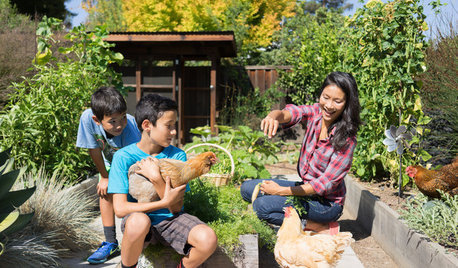Squash backcross to a parent or self F1s?
jmsieglaff
10 years ago
Related Stories

HOLIDAYSSurviving the Christmas Countdown: A Parent's Guide
Make things easier on yourself, for heaven's sake — and for the sake of truly enjoying the holiday with your family
Full Story
LIFETell Us: Do You Know How to Live With Your Parents?
If you've tried multigenerational living under one roof, we'd love to hear the details
Full Story
MOST POPULARMy Houzz: Hip Midcentury Style for a Mom's Backyard Cottage
This 1-bedroom suite has everything a Texas mother and grandmother needs — including the best wake-up system money can't buy
Full Story
FEEL-GOOD HOME21 Ways to Waste Less at Home
Whether it's herbs rotting in the fridge or clothes that never get worn, most of us waste too much. Here are ways to make a change
Full Story
FUN HOUZZHouzz Call: What’s on Your Refrigerator?
Magnets, menus, children’s art, coupons, perfect-attendance certificates, song lyrics — what is fridge-worthy in your house?
Full Story
ENTERTAININGModern Manners: Smooth Moves for Kids' Visits
For hosting kids or visiting with Junior in tow, we give you a plan to keep stress levels low and fun levels high
Full Story
DECORATING GUIDESBring in da Funk: How Humble Touches Give a Home Soul
Shake up expectations and stir up interest with pieces that show patina, create contrast or offer a jolt of surprise
Full Story
MOST POPULARThanksgiving Tales: When the Turkey Tanks
Houzz readers prove adept at snatching victory from the jaws of entertaining defeat
Full Story
FARM YOUR YARDHow to Farm Your Parking Strip
Get an up-close look at a thriving street-side edible garden, one of many sprouting up in Seattle
Full Story
HOUZZ TV FAVORITESHouzz TV: An Edible Backyard in an Eichler Home
A family of 4 brings form and function to a Silicon Valley yard with vegetable gardens, chickens, beehives and more
Full StorySponsored
Franklin County's Preferred Architectural Firm | Best of Houzz Winner
More Discussions






zen_man
Related Professionals
Horsham Landscape Architects & Landscape Designers · Marina Landscape Architects & Landscape Designers · Waterbury Landscape Contractors · Edmond Landscape Contractors · Maple Valley Landscape Contractors · Bedford Heights Landscape Contractors · Coconut Grove Carpenters · Franklin Park Carpenters · Miami Carpenters · Bethesda Fence Contractors · Laguna Hills Fence Contractors · Lake Jackson Fence Contractors · Memphis Fence Contractors · Voorhees Fence Contractors · West Sacramento Fence Contractors